NISSAN PATHFINDER 1999 R50 / 2.G Owner's Guide
Manufacturer: NISSAN, Model Year: 1999, Model line: PATHFINDER, Model: NISSAN PATHFINDER 1999 R50 / 2.GPages: 274, PDF Size: 2.34 MB
Page 31 of 274
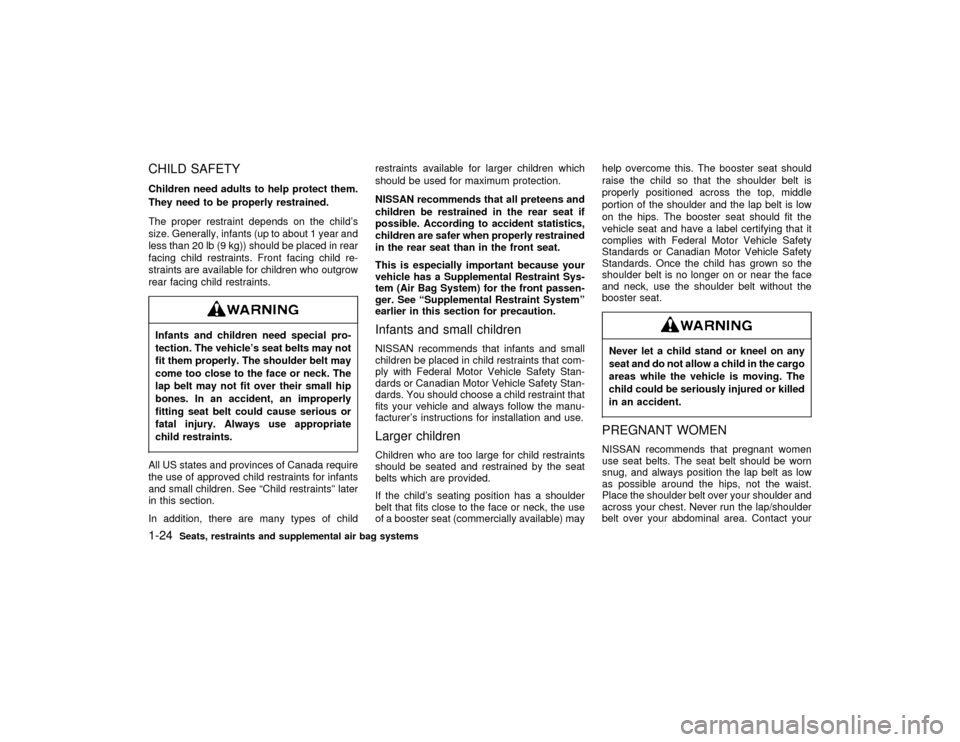
CHILD SAFETYChildren need adults to help protect them.
They need to be properly restrained.
The proper restraint depends on the child's
size. Generally, infants (up to about 1 year and
less than 20 lb (9 kg)) should be placed in rear
facing child restraints. Front facing child re-
straints are available for children who outgrow
rear facing child restraints.Infants and children need special pro-
tection. The vehicle's seat belts may not
fit them properly. The shoulder belt may
come too close to the face or neck. The
lap belt may not fit over their small hip
bones. In an accident, an improperly
fitting seat belt could cause serious or
fatal injury. Always use appropriate
child restraints.All US states and provinces of Canada require
the use of approved child restraints for infants
and small children. See ªChild restraintsº later
in this section.
In addition, there are many types of childrestraints available for larger children which
should be used for maximum protection.
NISSAN recommends that all preteens and
children be restrained in the rear seat if
possible. According to accident statistics,
children are safer when properly restrained
in the rear seat than in the front seat.
This is especially important because your
vehicle has a Supplemental Restraint Sys-
tem (Air Bag System) for the front passen-
ger. See ªSupplemental Restraint Systemº
earlier in this section for precaution.
Infants and small childrenNISSAN recommends that infants and small
children be placed in child restraints that com-
ply with Federal Motor Vehicle Safety Stan-
dards or Canadian Motor Vehicle Safety Stan-
dards. You should choose a child restraint that
fits your vehicle and always follow the manu-
facturer's instructions for installation and use.Larger childrenChildren who are too large for child restraints
should be seated and restrained by the seat
belts which are provided.
If the child's seating position has a shoulder
belt that fits close to the face or neck, the use
of a booster seat (commercially available) mayhelp overcome this. The booster seat should
raise the child so that the shoulder belt is
properly positioned across the top, middle
portion of the shoulder and the lap belt is low
on the hips. The booster seat should fit the
vehicle seat and have a label certifying that it
complies with Federal Motor Vehicle Safety
Standards or Canadian Motor Vehicle Safety
Standards. Once the child has grown so the
shoulder belt is no longer on or near the face
and neck, use the shoulder belt without the
booster seat.
Never let a child stand or kneel on any
seat and do not allow a child in the cargo
areas while the vehicle is moving. The
child could be seriously injured or killed
in an accident.PREGNANT WOMENNISSAN recommends that pregnant women
use seat belts. The seat belt should be worn
snug, and always position the lap belt as low
as possible around the hips, not the waist.
Place the shoulder belt over your shoulder and
across your chest. Never run the lap/shoulder
belt over your abdominal area. Contact your
1-24
Seats, restraints and supplemental air bag systems
Z
01.1.22/R50-D/V5
X
Page 32 of 274
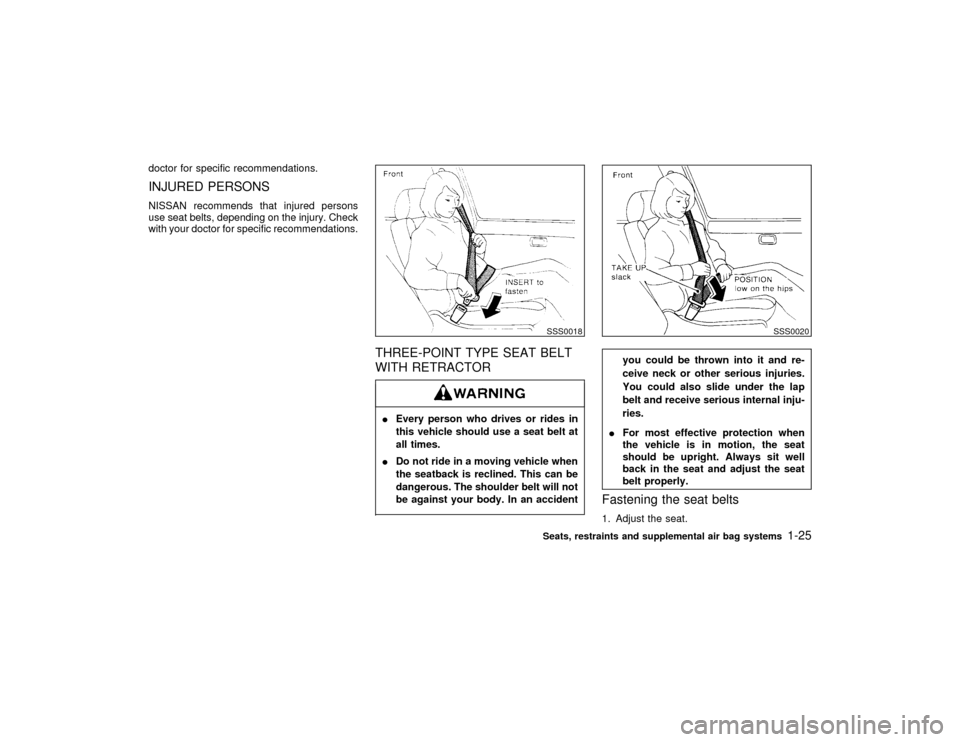
doctor for specific recommendations.INJURED PERSONSNISSAN recommends that injured persons
use seat belts, depending on the injury. Check
with your doctor for specific recommendations.
THREE-POINT TYPE SEAT BELT
WITH RETRACTORIEvery person who drives or rides in
this vehicle should use a seat belt at
all times.
IDo not ride in a moving vehicle when
the seatback is reclined. This can be
dangerous. The shoulder belt will not
be against your body. In an accident
you could be thrown into it and re-
ceive neck or other serious injuries.
You could also slide under the lap
belt and receive serious internal inju-
ries.
IFor most effective protection when
the vehicle is in motion, the seat
should be upright. Always sit well
back in the seat and adjust the seat
belt properly.
Fastening the seat belts1. Adjust the seat.
SSS0018
SSS0020
Seats, restraints and supplemental air bag systems
1-25
Z
01.1.22/R50-D/V5
X
Page 33 of 274
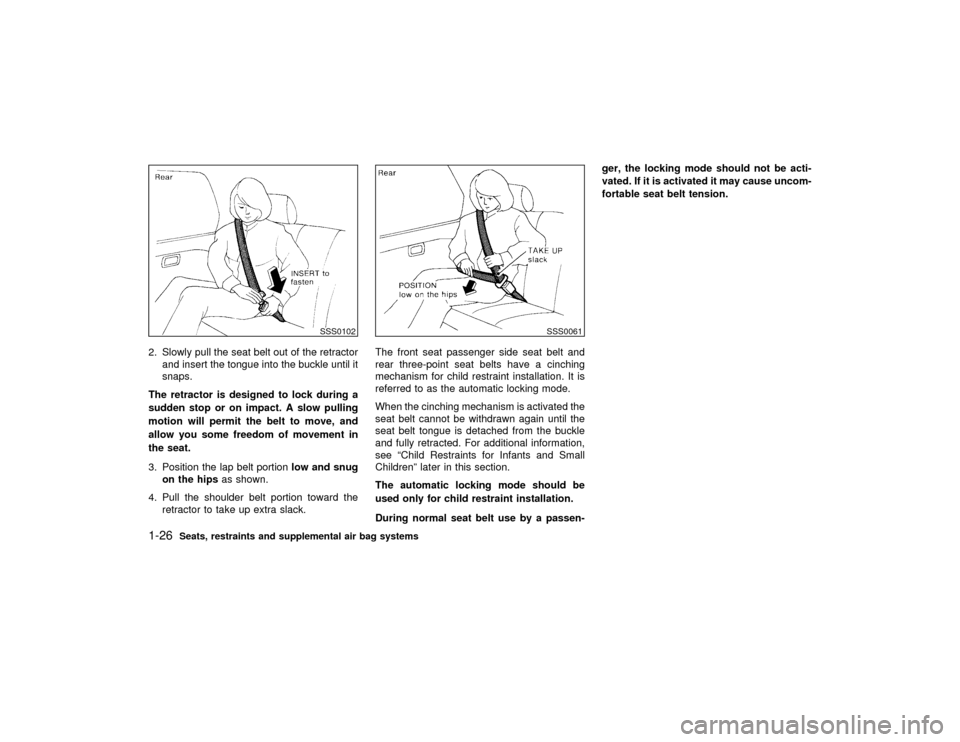
2. Slowly pull the seat belt out of the retractor
and insert the tongue into the buckle until it
snaps.
The retractor is designed to lock during a
sudden stop or on impact. A slow pulling
motion will permit the belt to move, and
allow you some freedom of movement in
the seat.
3. Position the lap belt portionlow and snug
on the hipsas shown.
4. Pull the shoulder belt portion toward the
retractor to take up extra slack.The front seat passenger side seat belt and
rear three-point seat belts have a cinching
mechanism for child restraint installation. It is
referred to as the automatic locking mode.
When the cinching mechanism is activated the
seat belt cannot be withdrawn again until the
seat belt tongue is detached from the buckle
and fully retracted. For additional information,
see ªChild Restraints for Infants and Small
Childrenº later in this section.
The automatic locking mode should be
used only for child restraint installation.
During normal seat belt use by a passen-ger, the locking mode should not be acti-
vated. If it is activated it may cause uncom-
fortable seat belt tension.
SSS0102
SSS0061
1-26
Seats, restraints and supplemental air bag systems
Z
01.1.22/R50-D/V5
X
Page 34 of 274
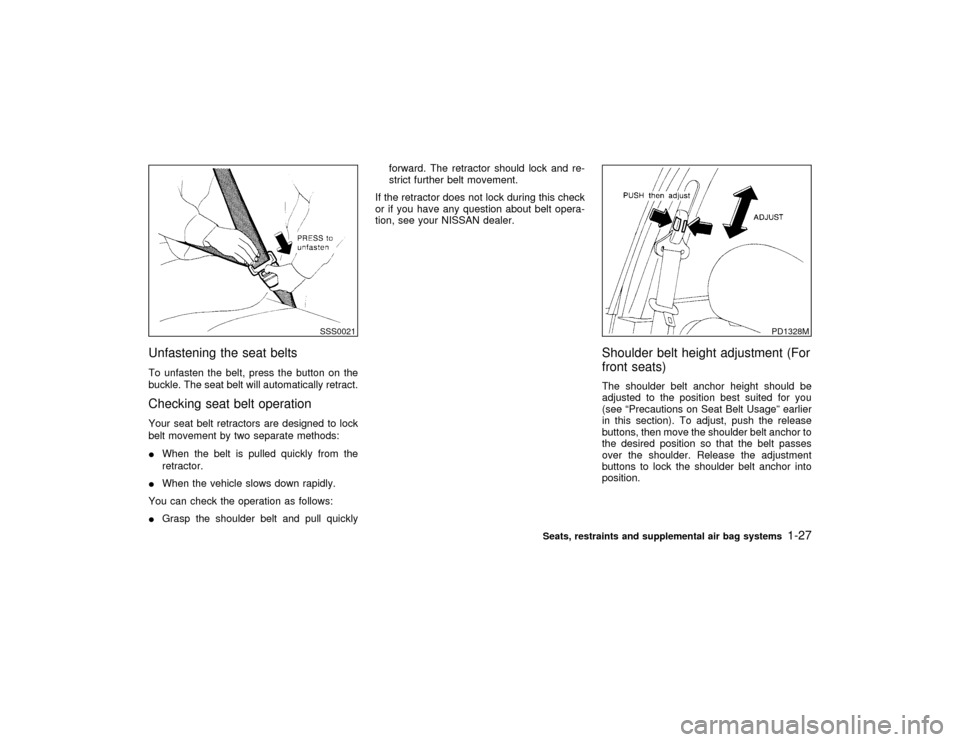
Unfastening the seat beltsTo unfasten the belt, press the button on the
buckle. The seat belt will automatically retract.Checking seat belt operationYour seat belt retractors are designed to lock
belt movement by two separate methods:
IWhen the belt is pulled quickly from the
retractor.
IWhen the vehicle slows down rapidly.
You can check the operation as follows:
IGrasp the shoulder belt and pull quicklyforward. The retractor should lock and re-
strict further belt movement.
If the retractor does not lock during this check
or if you have any question about belt opera-
tion, see your NISSAN dealer.
Shoulder belt height adjustment (For
front seats)The shoulder belt anchor height should be
adjusted to the position best suited for you
(see ªPrecautions on Seat Belt Usageº earlier
in this section). To adjust, push the release
buttons, then move the shoulder belt anchor to
the desired position so that the belt passes
over the shoulder. Release the adjustment
buttons to lock the shoulder belt anchor into
position.
SSS0021
PD1328M
Seats, restraints and supplemental air bag systems
1-27
Z
01.1.22/R50-D/V5
X
Page 35 of 274
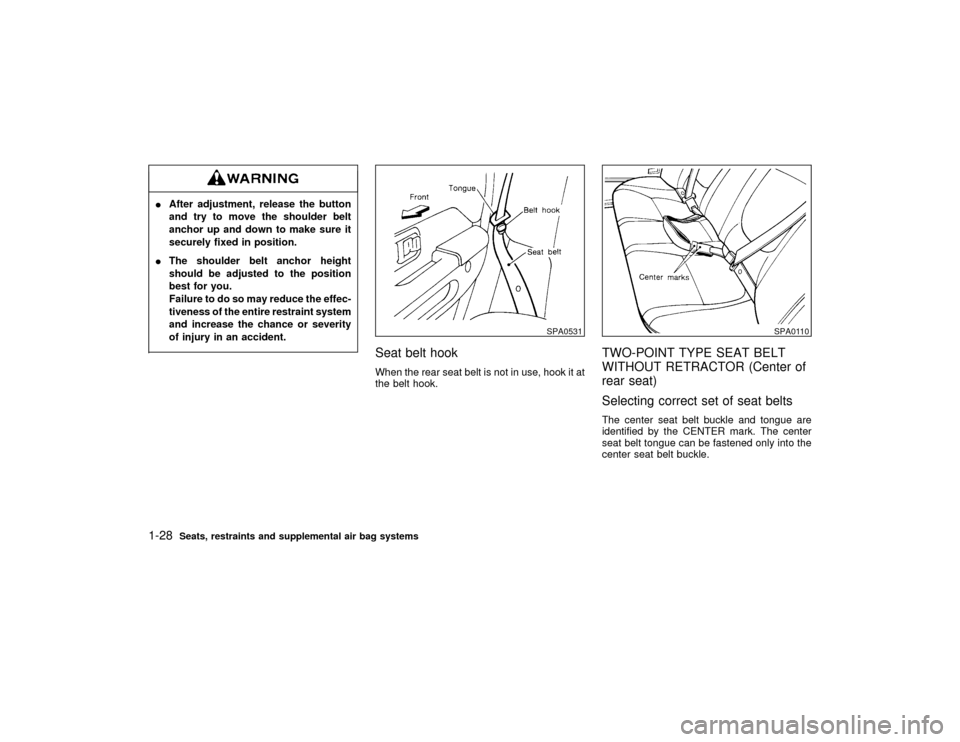
IAfter adjustment, release the button
and try to move the shoulder belt
anchor up and down to make sure it
securely fixed in position.
IThe shoulder belt anchor height
should be adjusted to the position
best for you.
Failure to do so may reduce the effec-
tiveness of the entire restraint system
and increase the chance or severity
of injury in an accident.
Seat belt hookWhen the rear seat belt is not in use, hook it at
the belt hook.
TWO-POINT TYPE SEAT BELT
WITHOUT RETRACTOR (Center of
rear seat)
Selecting correct set of seat beltsThe center seat belt buckle and tongue are
identified by the CENTER mark. The center
seat belt tongue can be fastened only into the
center seat belt buckle.
SPA0531
SPA0110
1-28
Seats, restraints and supplemental air bag systems
Z
01.1.22/R50-D/V5
X
Page 36 of 274
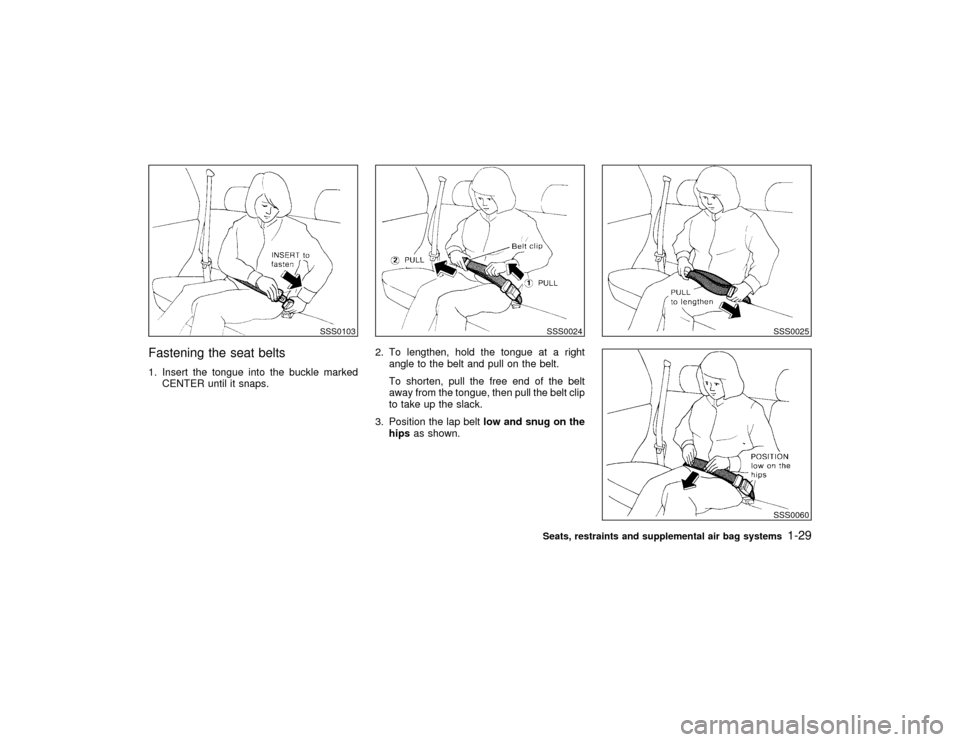
Fastening the seat belts1. Insert the tongue into the buckle marked
CENTER until it snaps.2. To lengthen, hold the tongue at a right
angle to the belt and pull on the belt.
To shorten, pull the free end of the belt
away from the tongue, then pull the belt clip
to take up the slack.
3. Position the lap beltlow and snug on the
hipsas shown.
SSS0103
SSS0024
SSS0025SSS0060
Seats, restraints and supplemental air bag systems
1-29
Z
01.1.22/R50-D/V5
X
Page 37 of 274
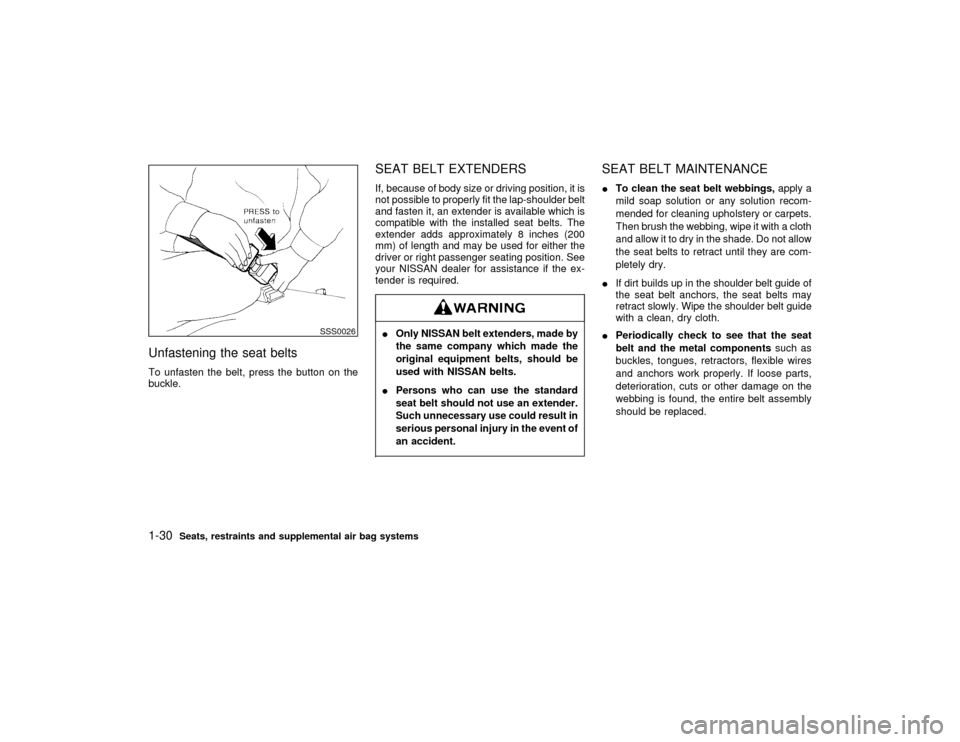
Unfastening the seat beltsTo unfasten the belt, press the button on the
buckle.
SEAT BELT EXTENDERSIf, because of body size or driving position, it is
not possible to properly fit the lap-shoulder belt
and fasten it, an extender is available which is
compatible with the installed seat belts. The
extender adds approximately 8 inches (200
mm) of length and may be used for either the
driver or right passenger seating position. See
your NISSAN dealer for assistance if the ex-
tender is required.IOnly NISSAN belt extenders, made by
the same company which made the
original equipment belts, should be
used with NISSAN belts.
IPersons who can use the standard
seat belt should not use an extender.
Such unnecessary use could result in
serious personal injury in the event of
an accident.
SEAT BELT MAINTENANCEITo clean the seat belt webbings,apply a
mild soap solution or any solution recom-
mended for cleaning upholstery or carpets.
Then brush the webbing, wipe it with a cloth
and allow it to dry in the shade. Do not allow
the seat belts to retract until they are com-
pletely dry.
IIf dirt builds up in the shoulder belt guide of
the seat belt anchors, the seat belts may
retract slowly. Wipe the shoulder belt guide
with a clean, dry cloth.
IPeriodically check to see that the seat
belt and the metal componentssuch as
buckles, tongues, retractors, flexible wires
and anchors work properly. If loose parts,
deterioration, cuts or other damage on the
webbing is found, the entire belt assembly
should be replaced.
SSS0026
1-30
Seats, restraints and supplemental air bag systems
Z
01.1.22/R50-D/V5
X
Page 38 of 274
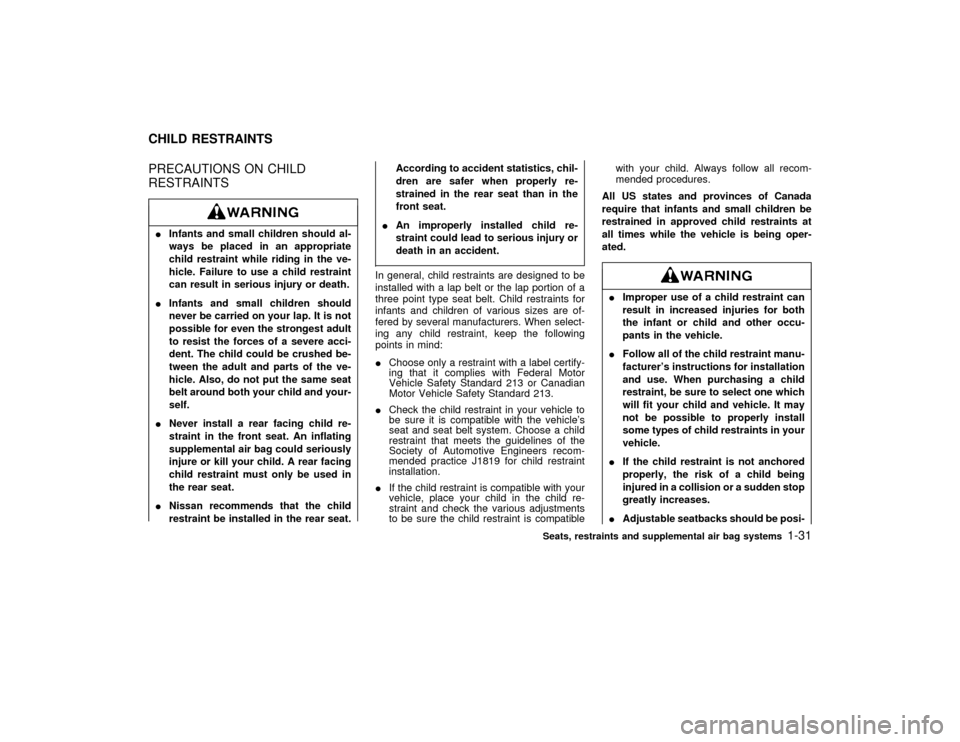
PRECAUTIONS ON CHILD
RESTRAINTSIInfants and small children should al-
ways be placed in an appropriate
child restraint while riding in the ve-
hicle. Failure to use a child restraint
can result in serious injury or death.
IInfants and small children should
never be carried on your lap. It is not
possible for even the strongest adult
to resist the forces of a severe acci-
dent. The child could be crushed be-
tween the adult and parts of the ve-
hicle. Also, do not put the same seat
belt around both your child and your-
self.
INever install a rear facing child re-
straint in the front seat. An inflating
supplemental air bag could seriously
injure or kill your child. A rear facing
child restraint must only be used in
the rear seat.
INissan recommends that the child
restraint be installed in the rear seat.According to accident statistics, chil-
dren are safer when properly re-
strained in the rear seat than in the
front seat.
IAn improperly installed child re-
straint could lead to serious injury or
death in an accident.
In general, child restraints are designed to be
installed with a lap belt or the lap portion of a
three point type seat belt. Child restraints for
infants and children of various sizes are of-
fered by several manufacturers. When select-
ing any child restraint, keep the following
points in mind:
IChoose only a restraint with a label certify-
ing that it complies with Federal Motor
Vehicle Safety Standard 213 or Canadian
Motor Vehicle Safety Standard 213.
ICheck the child restraint in your vehicle to
be sure it is compatible with the vehicle's
seat and seat belt system. Choose a child
restraint that meets the guidelines of the
Society of Automotive Engineers recom-
mended practice J1819 for child restraint
installation.
IIf the child restraint is compatible with your
vehicle, place your child in the child re-
straint and check the various adjustments
to be sure the child restraint is compatiblewith your child. Always follow all recom-
mended procedures.
All US states and provinces of Canada
require that infants and small children be
restrained in approved child restraints at
all times while the vehicle is being oper-
ated.
IImproper use of a child restraint can
result in increased injuries for both
the infant or child and other occu-
pants in the vehicle.
IFollow all of the child restraint manu-
facturer's instructions for installation
and use. When purchasing a child
restraint, be sure to select one which
will fit your child and vehicle. It may
not be possible to properly install
some types of child restraints in your
vehicle.
IIf the child restraint is not anchored
properly, the risk of a child being
injured in a collision or a sudden stop
greatly increases.
IAdjustable seatbacks should be posi-
CHILD RESTRAINTS
Seats, restraints and supplemental air bag systems
1-31
Z
01.1.22/R50-D/V5
X
Page 39 of 274
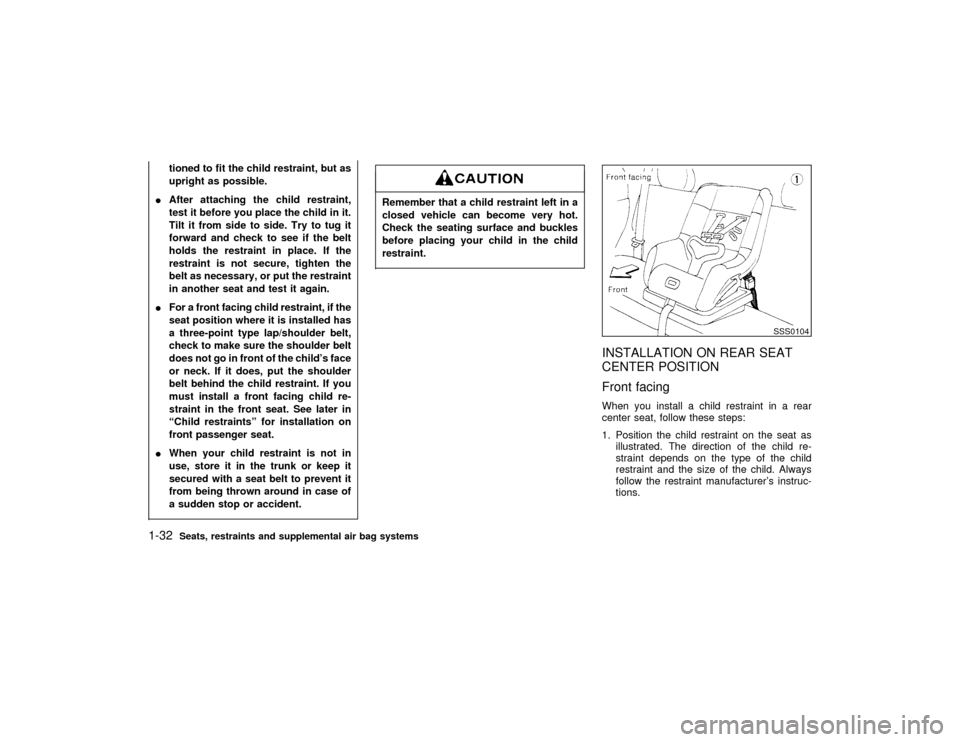
tioned to fit the child restraint, but as
upright as possible.
IAfter attaching the child restraint,
test it before you place the child in it.
Tilt it from side to side. Try to tug it
forward and check to see if the belt
holds the restraint in place. If the
restraint is not secure, tighten the
belt as necessary, or put the restraint
in another seat and test it again.
IFor a front facing child restraint, if the
seat position where it is installed has
a three-point type lap/shoulder belt,
check to make sure the shoulder belt
does not go in front of the child's face
or neck. If it does, put the shoulder
belt behind the child restraint. If you
must install a front facing child re-
straint in the front seat. See later in
ªChild restraintsº for installation on
front passenger seat.
IWhen your child restraint is not in
use, store it in the trunk or keep it
secured with a seat belt to prevent it
from being thrown around in case of
a sudden stop or accident.
Remember that a child restraint left in a
closed vehicle can become very hot.
Check the seating surface and buckles
before placing your child in the child
restraint.
INSTALLATION ON REAR SEAT
CENTER POSITION
Front facingWhen you install a child restraint in a rear
center seat, follow these steps:
1. Position the child restraint on the seat as
illustrated. The direction of the child re-
straint depends on the type of the child
restraint and the size of the child. Always
follow the restraint manufacturer's instruc-
tions.
SSS0104
1-32
Seats, restraints and supplemental air bag systems
Z
01.1.22/R50-D/V5
X
Page 40 of 274
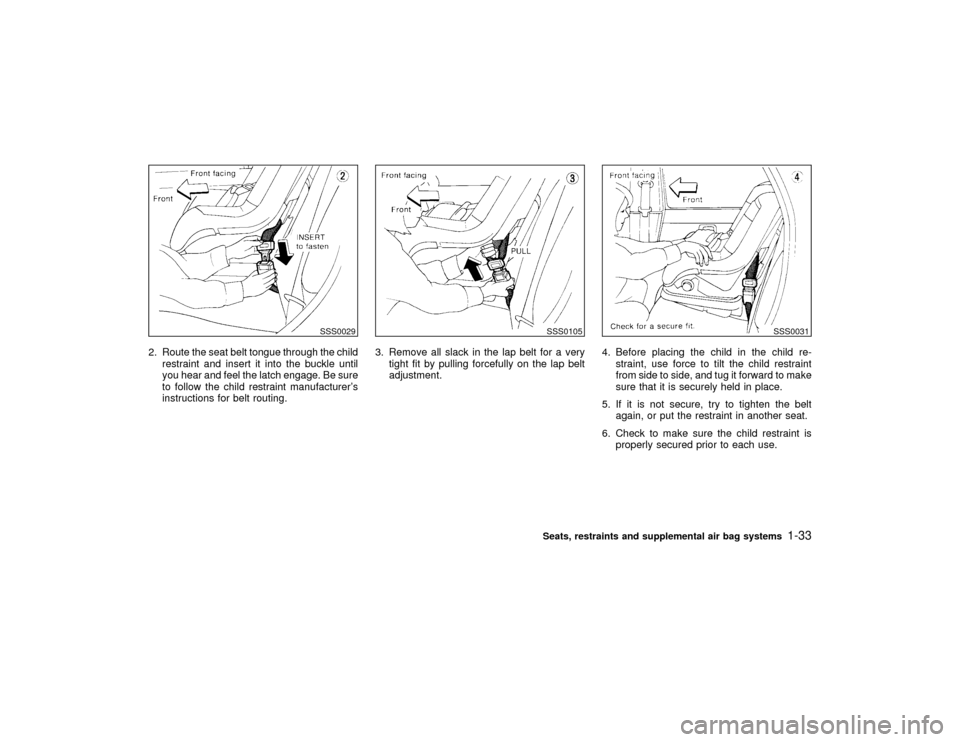
2. Route the seat belt tongue through the child
restraint and insert it into the buckle until
you hear and feel the latch engage. Be sure
to follow the child restraint manufacturer's
instructions for belt routing.3. Remove all slack in the lap belt for a very
tight fit by pulling forcefully on the lap belt
adjustment.4. Before placing the child in the child re-
straint, use force to tilt the child restraint
from side to side, and tug it forward to make
sure that it is securely held in place.
5. If it is not secure, try to tighten the belt
again, or put the restraint in another seat.
6. Check to make sure the child restraint is
properly secured prior to each use.
SSS0029
SSS0105
SSS0031
Seats, restraints and supplemental air bag systems
1-33
Z
01.1.22/R50-D/V5
X